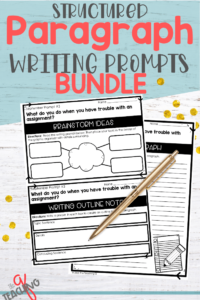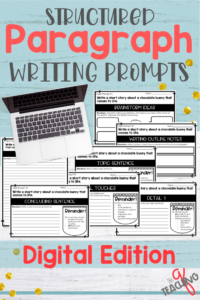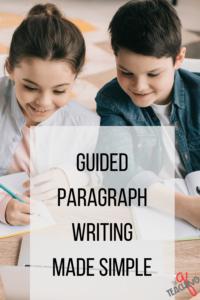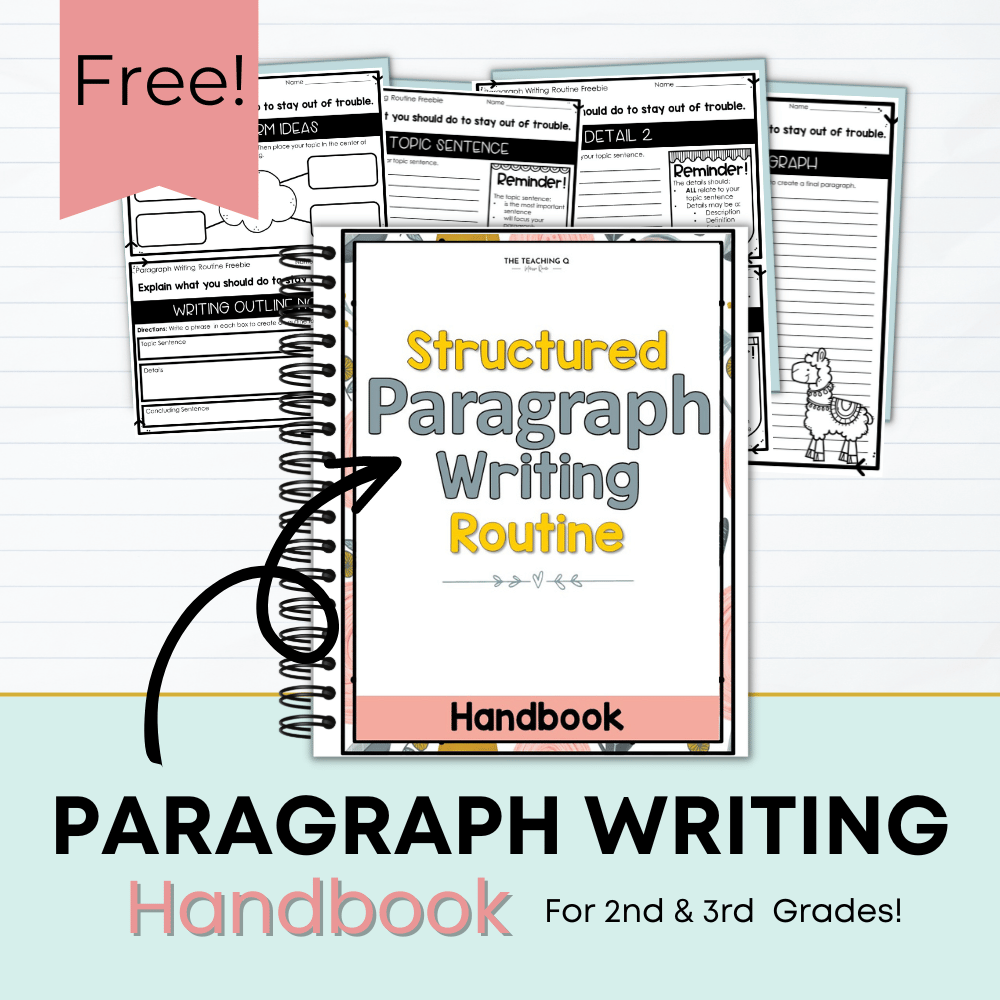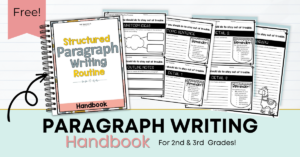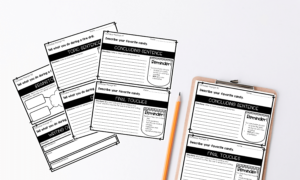Are your students excited and eager when it comes to writing? Maybe they’re a little hesitant? No matter what your situation, I have something for you!
Here are some simple step-by-step advice for teaching students how to write effective paragraphs without all the complaining. This step by step guide will provide your students with a structured paragraph skill to use with any prompt.
Guide Your Paragraph Writing with Brainstormed Ideas
The first step in a guided paragraph writing session is to brainstorm your paragraph ideas with your class. Paragraph writing becomes fun and easy with a good brainstorm session. Students love being verbal and sharing out ideas, this is an instant attention grabber.
The paragraph brainstorming can be done whole class, with partners, or individually. Whichever you choose will most likely be based on your students and their comfort with the skill set.
My favorite form of brainstorming is an old faithful, the web. Typically, the “big idea” is placed in the middle, with supporting details branching out. The visual is simple yet critical for students to stay focused.
During the brainstorming phase, it is essential for the class to discuss and confirm that each detail is actually related to the topic. If this step is not neglected, a well-focused paragraph will develop.

The Paragraph Outline
A writing outline is next on your to-do list. Although most students want to get straight to their paragraph writing, don’t let them!
The outline will take your student’s brainstormed web and move it to a structured and guided format. I always tell my students that they are merely taking the web ideas and arranging them into a sequence order, using small phrases. Immediate sighs of relief are then heard throughout the room. (I love it!)
For any paragraph writing outline, it’s important to note; the outline requires words or phrases of ideas. There are no sentences yet! The draft should not “overwhelm” the student but instead, create a structure to support the upcoming writing.
Guided Topic Sentence
To create a solidly structured and guided paragraph, the topic sentence is vital! For this reason, I choose to keep the topic sentence a writing block all to itself.
Before writing the topic sentence, the students review their writing outlines. Some key elements to remember when writing a topic sentence is that it:
- the most important sentence
- will focus your paragraph (the big idea)
- will let the reader know what to expect in the paragraph

All the Details
A paragraph isn’t complete without the details! When teaching students to write add details to their paragraphs, it is important that students understand the details ALWAYS support the topic sentence. (We all know how easy it is for our young ones to get off-topic!)
During the guided details stage of paragraph writing, students will refer back to their paragraph outlines and extend their ideas. The following are a few suggestions to support the students when writing paragraph details. Details may be:
- descriptions
- definitions
- facts
- explanations
- examples
The type of detail chosen will be based on the kind of writing genre. The three writing styles covered heavily in my room are narratives, informative, and opinion writing. No matter what genre you are working on, students should become familiar and fluid in using a variety of details in their writing.
I use a variety of writing prompts for a guided paragraph writing each month, covering all genres.

Create a Concluding Sentence
Next up for a guided paragraph writing lesson, is the concluding sentence. Although the concluding sentence is usually a pain point for most students, it no longer will be. By the time they have written a strong topic sentence, added all the supporting details, the students are usually “OVER IT!”
So, make the conclusion easy for them! Simply restate the topic sentence using other words. To help support the students, I place each student with a writing partner. The student reads the topic sentence to their partner and the partner repeats the topic in their own words. BAM! Wow, a concluding sentence instantly created!
But don’t stop there! Make sure students are aware that a concluding sentence should NOT have new information. (Yes, it’s amazing how often they try to plug in a new detail!) If you took time with your brainstormed web and outline, you should be able to avoid the new information surfacing.

Add those Final Touches
Oh, yes! Writing the paragraphs’ final touches are where it’s at!
To excite my students about adding the final touches, I write a simple and basic paragraph without the extras. Then I read them a second paragraph writing that includes all the final touches. Hands down, students enjoy the second writing more than the first and are full of compliments!
The paragraphs final touches may include:
- title
- hook sentence
- transitional words or phrases
- adjectives and adverbs
- figurative language
Edit, Revise & Publish the Paragraph
Lastly, our paragraph writing would not be complete without our last step: edit, revise and publish. Yes, it’s been a long journey, but please don’t let the students fade out now.
To increase student motivation and engagement, while editing and revising, I once again go to my handy dandy student partners. The editing and revising phase will surely provide your students will the feedback needed to bump up their writing level.
Finally, the students are ready to publish! Whew!
Within my own classroom, I mix up the publishing of the writing between a paper-pencil format and Google Slides online format. For two reasons I mix my format:
- I believe younger students still need to develop their penmanship and fine motor skill
- Also, I believe many students enjoy the digital version, therefor I get better engagement during these weeks.

Independently Guided Paragraphs
Although this post has been a bit lengthy, the overall weekly structured paragraph writing does not take long at all!
I assign this routine to my students each morning while I’m taking care of the daily business such as roll and lunch count.
The writing prompts I give to my students are simple and clear that do not need extra support. Since this is a time for “applying” their structured and guided paragraphs skills, my students know exactly what to work on each morning. The students work independently. Once my tasks are completed, I can monitor the room. The whole process usually takes 15-20 a day for 5 days a week.
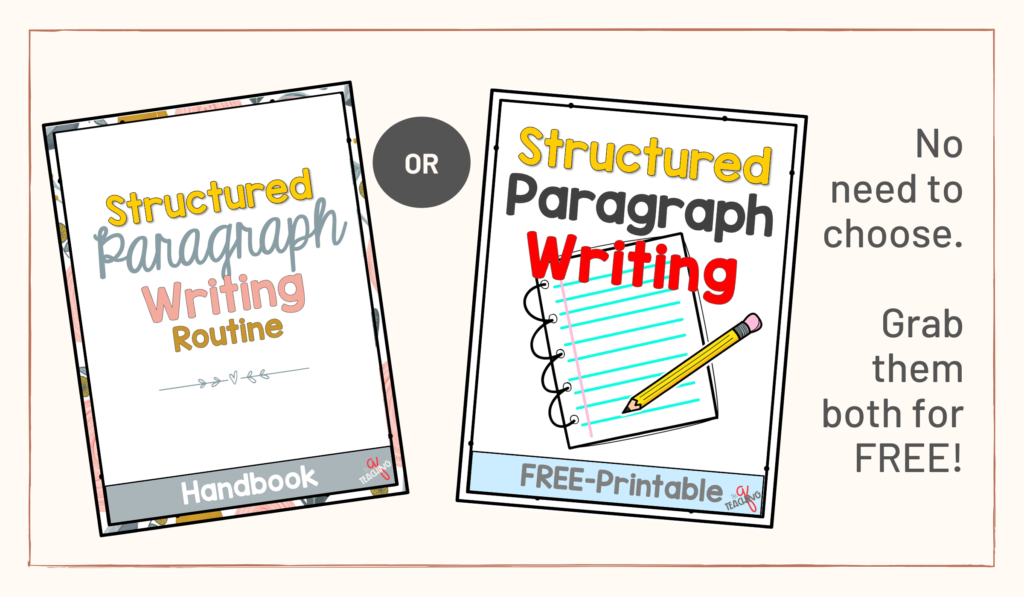
While we are on the subject of writing, make sure your students have a solid grasp of paragraph writing. Check out my FREE Structured Paragraph Handbook, which will guide you and your students through the steps needed to create the perfect paragraph.

If you’re wanting to try out this simple seven-steps to a guided paragraph writing, use the links below.
You may also click on the images at the bottom of the post.
- Paragraph Writing Prompts for Google Slides(BUNDLE)
- Weekly Paragraph Writing Prompts (August-May) BUNDLE
The Weekly Structured Paragraph Writing Prompts by month are the same prompts as the digital resource. If you choose to purchase the digital Google Slides and want to use the paper-pencil method as I do, this one resource will cover you. You can always print from the Google Slides. So cool.
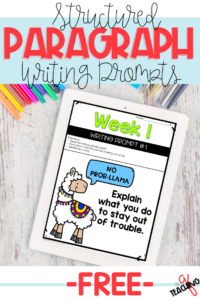
Try out two weeks of FREE Structured Paragraph Writing Prompts Here.
Also, let me know in the comments how your students are progressing with their paragraph writing skills.


